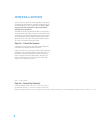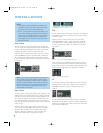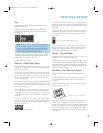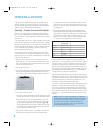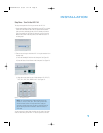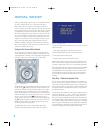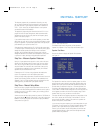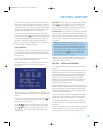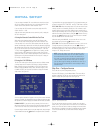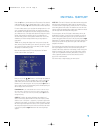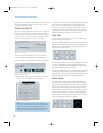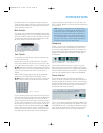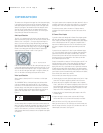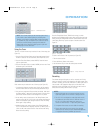
28
INITIAL SETUP
LEFT/RIGHT: This line tells the AVR 144 the capabilities of your front
left and right speakers. Use the ‹/› Buttons to select either SMALL
or LARGE for these speakers.
CENTER: Move the cursor to the line for the center speaker, and use
the ‹/› Buttons to select a setting for this speaker.
NOTE: If the receiver is currently in one of the Logic 7 surround
modes, which will be the case the first time you turn on the
receiver, you won’t be able to set the center speaker to LARGE,
due to the requirements of the Logic 7 processor.You may use
the SMALL setting instead. As you listen to the receiver, if you
find the SMALL setting is not satisfactory, change the surround
mode to one of the Dolby Pro Logic II modes (using the
Surround Select menu, accessible from the Master Menu), and
then you may come back to this menu and change the center
speaker to the LARGE setting.
SURROUND: Move the cursor to the line for the surround, or rear,
speakers, and use the ‹/› Buttons to select a setting for these
two speakers.
SUBWOOFER: Move the cursor to the line for the subwoofer, which is
programmed a little differently. The subwoofer’s “size” setting depends
upon how you programmed the front left and right speakers.
• If you set the front speakers to SMALL, the subwoofer setting will
be SUB, and you won’t be able to change it.All low-frequency
information will always be sent to the subwoofer. If you don’t have
a subwoofer, you may wish to set your front speakers to LARGE
so as not to lose this information, but you may need to lower the
volume to avoid adverse results.
• If you set the front speakers to LARGE, you may select from three
possible settings for the subwoofer.
•
L/R+LFE: This setting sends all low-frequency information to the
subwoofer, including both information that would normally be
played through the front left and right speakers and the special
low-frequency effects (LFE) channel information.
• LFE: This setting plays low-frequency information contained in
the left and right program channels to the front speakers, and
directs only the LFE channel information to the subwoofer.
• NONE: This setting steers all low-frequency information to the
front speakers, and no information to the subwoofer output. Use
this setting if you have a passive subwoofer, or a powered sub-
woofer that you connected to the front speaker outputs.
NOTE: If you are using a Harman Kardon HKTS speaker sys-
tem, select the SMALL setting for the LEFT/RIGHT, CENTER
and SURROUND lines, and the subwoofer will automatically be
set to SUB.
BASS MGR: This advanced setting is used if you wish to configure your
speakers differently for different sources. For example, you may prefer to
set your speakers to LARGE while listening to CDs from your CD player.
By changing this setting to INDEPENDENT, you may have different set-
tings for your CD player and your DVD player or other devices.We rec-
ommend that you leave this setting at its factory default of GLOBAL until
you have more experience with the AVR.
Move the cursor to the BACK TO MANUAL SETUP line and press the
Set Button to return to the Manual Setup Menu.
NOTE: The Speaker/Channel Indicators on the front panel of
the receiver will display the speaker size settings as follows. For
each speaker configured as SMALL, a single box will appear in
the position for that speaker. For each speaker configured as
LARGE, a double box will appear in its position. If a speaker is
configured as NONE, no box will appear.The subwoofer will be
indicated by a single box, or no box if no subwoofer has been
configured. The letters inside the boxes appear when a digital
signal is being received that has that channel discretely encoded.
The letters flash when the signal is not present, such as when a
DVD is paused.
Figure 35 – Speaker/Channel Input Indicators
Speaker Crossover Menu
On the Manual Setup menu, move the cursor to the SPEAKER X-OVER
line and press the Set Button to display the Speaker Crossover menu.
See Figure 36.
Figure 36 – Speaker Crossover Menu Screen
Setting the Speaker Crossover menu correctly ensures that your speakers
are properly used so that they sound their best. Although you could skip
this step the first time you use the receiver, we recommend that you
take the few extra minutes to enter the correct crossover settings.
You may select from seven possible settings: 40Hz, 60Hz, 80Hz,
100Hz, 120Hz, 150Hz or 200Hz. Depending upon the frequency
response of your speakers which you recorded in Step One –
Determine Speaker Size, for each speaker group select the number
that matches or is just above the low end of your speaker’s frequency
response.
HKP1482AVR144-om 9/7/06 3:12 PM Page 28



